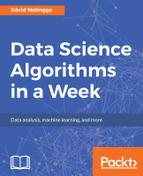Book Description
Build strong foundation of machine learning algorithms In 7 days.
About This Book
- Get to know seven algorithms for your data science needs in this concise, insightful guide
- Ensure you're confident in the basics by learning when and where to use various data science algorithms
- Learn to use machine learning algorithms in a period of just 7 days
Who This Book Is For
This book is for aspiring data science professionals who are familiar with Python and have a statistics background. It is ideal for developers who are currently implementing one or two data science algorithms and want to learn more to expand their skill set.
What You Will Learn
- Find out how to classify using Naive Bayes, Decision Trees, and Random Forest to achieve accuracy to solve complex problems
- Identify a data science problem correctly and devise an appropriate prediction solution using Regression and Time-series
- See how to cluster data using the k-Means algorithm
- Get to know how to implement the algorithms efficiently in the Python and R languages
In Detail
Machine learning applications are highly automated and self-modifying, and they continue to improve over time with minimal human intervention as they learn with more data. To address the complex nature of various real-world data problems, specialized machine learning algorithms have been developed that solve these problems perfectly. Data science helps you gain new knowledge from existing data through algorithmic and statistical analysis.
This book will address the problems related to accurate and efficient data classification and prediction. Over the course of 7 days, you will be introduced to seven algorithms, along with exercises that will help you learn different aspects of machine learning. You will see how to pre-cluster your data to optimize and classify it for large datasets. You will then find out how to predict data based on the existing trends in your datasets.
This book covers algorithms such as: k-Nearest Neighbors, Naive Bayes, Decision Trees, Random Forest, k-Means, Regression, and Time-series. On completion of the book, you will understand which machine learning algorithm to pick for clustering, classification, or regression and which is best suited for your problem.
Style and approach
Machine learning applications are highly automated and self-modifying which continue to improve over time with minimal human intervention as they learn with more data. To address the complex nature of various real world data problems, specialized machine learning algorithms have been developed that solve these problems perfectly.
